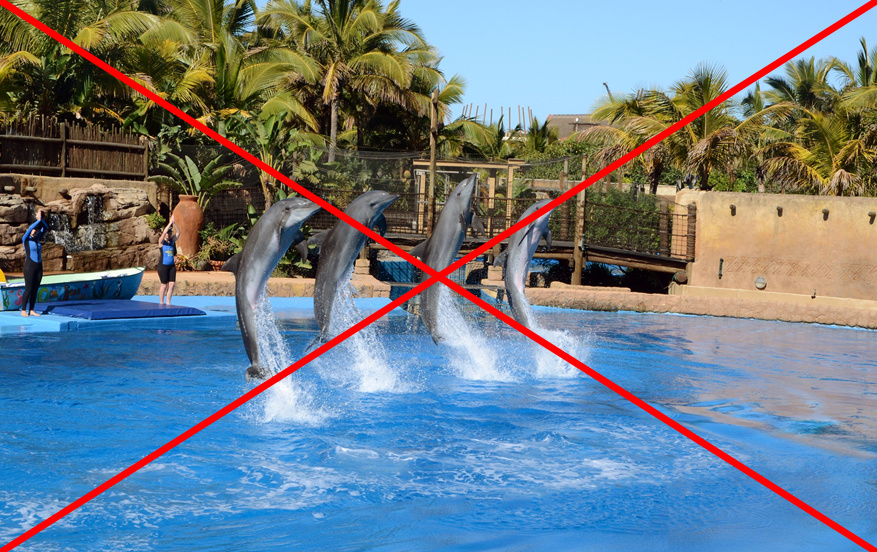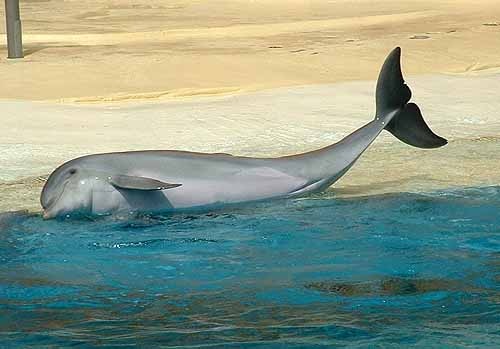10 Good Reasons Not To Go To A Dolphinarium

I have recently signed up to the newsletter of the blog “The Dolphin Connection” , and I got my first newsletter this morning! “10 good reasons not to go to a dolphinarium”.
It’s a French article so I’ll just translate in English.
10 good reasons not to go to a dolphinarium… Or why becoming a dolphin trainer is not a career project.
Dolphinariums send the image of a playful dolphin, docile, and willing to entertain us. But behind this outward appearance lies a sad reality: the one of intelligent animals slaved by food and suffering from captivity.
Here are 10 good reasons no to go to places where captive dolphins are being used for their show. These reasons are also valid for those who dream of becoming a dolphin trainer one day. Luckily, there are other careers allowing to live one’s passion.
- Captive dolphins are controlled by food. A big dolphin can eat up to 55lb of fish per day! A trick for a fish represents a thin reward. As soon as they have eaten their fill, dolphins cease to obey orders. This is what Richard O’Barry explains. This reason that the former trainer of Flipper’s show used to use 5 Bottlenose dolphins for the shooting of the show.
- A captive dolphin doesn’t live as long as a free dolphin. A wild dolphin can live up to 40-50 years. In dolphinariums, life expectancy is at least divided by two. Dolphins suffer from stress, skin illness due to bleached water, and sometimes, they can mutilate themselves and even commit suicide… (“Flipper committed suicide” as Richard O’Barry asserts.)
- Dolphins of marine parks have to be, most of the time, captured from the wild. In dolphinarium, reproduction is difficult (but possible). In addition to hurt and sometimes kill the dolphins during the capture process, these abductions have terrible impacts on the group of wild dolphins, which see themselves being cut from one or many of their kind. Dolphins are highly sociable animals and the loss of one of their kind can turn their lives upside down.
- Dolphins being locked up in a seaquariums, particularly those which have been captured in the wild, find themselves away from those they used to live with. They come from different places and groups; they don’t speak the same language, they don’t have the same culture. They are forced to live with strangers and it contributes to their stress.

- The need maintained by dolphinariums leads to massacres which happen, among others, in Japan. This reality is described in the movie The Cove. This movie shows fishermen grouping dolphins together, then selecting the prettiest of them to sell them to dolphinariums at prices that can reach 150 000 $. And the other thousands of dolphins gathered are butchered to be sold in Japanese supermarkets or school restaurants. You can act right now by signing the petition to stop the Taiji slaughter.
- Seaquariums participate in a form of wrong education. Seeing locked up dolphins, sick and stressed out, doing tricks does not contributes at educating the audience about these creatures’ behaviour. Employees of dolphinariums pretend that dolphins love to do tricks and that they are happy to be there… But we are dealing with wild animals, which are not born to entertain us but, on the contrary, to be free.
- Going to see captive dolphins means supporting the idea that there is still an urging need for these kinds of shows. It means participating in the prosperity of this industry. Money is here the core of the war: if dolphinariums were not profitable, they would have disappeared a long time ago.

Dolphin gone crazy beaching himself out of the tank - Being locked up means not being able to have a decent life. Captivity is incompatible with the satisfaction of fulfilling the dolphin’s natural needs. In the ocean, they hunt and can swim many miles a day. In dolphinariums, they eat dead fish and turn around in their tank. Their training and their lives’ conditions end up killing them; captive dolphins become crazy, practising incest, self-mutilation and against nature behaviour.
- Buying tickets to a cetacean show in a marine park, also means contributing at information retention about the dolphin’s real capacities. In the United States, military research and the dolphinarium industry are connected by common interests. Kenneth LeVasseur, among others, asserts so: if some of the scientists financed by the Office of Naval Research (that is to say, most of them!) consider so low the intelligence of dolphins, it is because it would be ethically unacceptable to keep captive animals of intelligence comparable to ours.
- The best reason not to go to a dolphinarium is, if we love dolphins, we cannot accept to see them suffer like this. It is possible to have dolphins’ encounters while respecting them: by going to their natural habitat rather than by abducting them from it and force them to live according to our standards. Wild dolphins have always been but friendly to us, for thousands of years: they swing along our boats, with us, come to us, bond with us and sometimes rescue us.